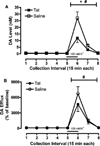In vivo microdialysis in awake, freely moving rats demonstrates HIV-1 Tat-induced alterations in dopamine transmission
- PMID: 19086089
- PMCID: PMC3704183
- DOI: 10.1002/syn.20594
In vivo microdialysis in awake, freely moving rats demonstrates HIV-1 Tat-induced alterations in dopamine transmission
Abstract
Individuals infected with human immunodeficiency virus (HIV) may develop neuropsychological impairment, and a modest percentage may progress to HIV-associated dementia (HAD). Research using human and nonhuman, in vitro and in vivo models, demonstrates that subcortical dopamine (DA) systems may be particularly vulnerable to HIV-induced neurodegeneration. The goal of the current investigation is to provide an understanding of the extent to which the HIV-1 protein Tat induces alterations in striatal DA transmission using in vivo brain microdialysis in awake, freely moving rats. The current study was designed to investigate Tat-induced neuronal dysfunction between 24-h and 48-h post-Tat administration, and demonstrates a reduction in evoked DA for the Tat-treated group relative to vehicle-treated group at 24 and 48 h. The Tat-induced reduction of DA overflow by 24 h suggests dysfunction of nerve terminals, and a compromised DA system in Tat-treated animals. Furthermore, the current study provides direct support for HIV-associated decline of DA function at a systemic level, helping to characterize the functional outcome of the relatively large amount of research on the molecular and behavioral levels of HIV-induced neurotoxicity. This initial study may provide additional characteristics of Tat-induced neuronal dysfunction to inform research on therapeutic intervention, and it provides a springboard for future in vivo research currently needed in the field.
(c) 2008 Wiley-Liss, Inc.
Figures




Similar articles
-
The human immunodeficiency virus-1-associated protein, Tat1-86, impairs dopamine transporters and interacts with cocaine to reduce nerve terminal function: a no-net-flux microdialysis study.Neuroscience. 2009 Apr 10;159(4):1292-9. doi: 10.1016/j.neuroscience.2009.01.024. Epub 2009 Jan 20. Neuroscience. 2009. PMID: 19344635 Free PMC article.
-
HIV-1 protein Tat potentiation of methamphetamine-induced decreases in evoked overflow of dopamine in the striatum of the rat.Brain Res. 2003 Sep 12;984(1-2):133-42. doi: 10.1016/s0006-8993(03)03122-6. Brain Res. 2003. PMID: 12932847
-
HIV-1 Tat protein-induced rapid and reversible decrease in [3H]dopamine uptake: dissociation of [3H]dopamine uptake and [3H]2beta-carbomethoxy-3-beta-(4-fluorophenyl)tropane (WIN 35,428) binding in rat striatal synaptosomes.J Pharmacol Exp Ther. 2009 Jun;329(3):1071-83. doi: 10.1124/jpet.108.150144. Epub 2009 Mar 26. J Pharmacol Exp Ther. 2009. PMID: 19325033 Free PMC article.
-
HIV, Tat and dopamine transmission.Neurobiol Dis. 2017 Sep;105:51-73. doi: 10.1016/j.nbd.2017.04.015. Epub 2017 Apr 27. Neurobiol Dis. 2017. PMID: 28457951 Free PMC article. Review.
-
The role of human dopamine transporter in NeuroAIDS.Pharmacol Ther. 2018 Mar;183:78-89. doi: 10.1016/j.pharmthera.2017.10.007. Epub 2017 Oct 5. Pharmacol Ther. 2018. PMID: 28987321 Free PMC article. Review.
Cited by
-
Chronic SSRI treatment reverses HIV-1 protein-mediated synaptodendritic damage.J Neurovirol. 2021 Jun;27(3):403-421. doi: 10.1007/s13365-021-00960-6. Epub 2021 May 18. J Neurovirol. 2021. PMID: 34003469 Free PMC article.
-
Evidence for developmental dopaminergic alterations in the human immunodeficiency virus-1 transgenic rat.J Neurovirol. 2010 Mar;16(2):168-73. doi: 10.3109/13550281003690177. J Neurovirol. 2010. PMID: 20337512 Free PMC article.
-
HIV-1 TAT protein enhances sensitization to methamphetamine by affecting dopaminergic function.Brain Behav Immun. 2017 Oct;65:210-221. doi: 10.1016/j.bbi.2017.05.004. Epub 2017 May 8. Brain Behav Immun. 2017. PMID: 28495611 Free PMC article.
-
Genetic predictor of working memory and prefrontal function in women with HIV.J Neurovirol. 2015 Feb;21(1):81-91. doi: 10.1007/s13365-014-0305-z. Epub 2014 Dec 17. J Neurovirol. 2015. PMID: 25515329 Free PMC article.
-
Didehydro-cortistatin A inhibits HIV-1 Tat mediated neuroinflammation and prevents potentiation of cocaine reward in Tat transgenic mice.Curr HIV Res. 2015;13(1):64-79. doi: 10.2174/1570162x13666150121111548. Curr HIV Res. 2015. PMID: 25613133 Free PMC article.
References
-
- Aksenov MY, Hasselrot U, Bansal AK, Wu G, Nath A, Anderson C, Mactutus CF, Booze RM. Oxidative damage induced by the injection of HIV-1 Tat protein in the rat striatum. Neurosci Lett. 2001;305:5–8. - PubMed
-
- Aksenov MY, Hasselrot U, Wu G, Nath A, Anderson C, Mactutus CF, Booze RM. Temporal relationships between HIV-1 Tat-induced neuronal degeneration, OX-42 immunoreactivity, reactive astrocytosis, and protein oxidation in the rat striatum. Brain Res. 2003;987:1–9. - PubMed
-
- Aksenov MY, Aksenova MV, Nath A, Ray PD, Mactutus CF, Booze RM. Cocaine-mediated enhancement of Tat toxicity in rat hippocampal cell cultures: The role of oxidative stress and D1 dopamine receptor. Neurotoxicology. 2006;27:217–228. - PubMed
-
- Bansal AK, Mactutus CF, Nath A, Maragos W, Hauser KF, Booze RM. Neurotoxicity of HIV-1 proteins gp120 and Tat in the rat striatum. Brain Res. 2000;879:42–49. - PubMed
-
- Berger JR, Arendt G. HIV dementia: The role of the basal ganglia and dopaminergic systems. J Psychopharmacol. 2000;14:214–221. - PubMed
Publication types
MeSH terms
Substances
Grants and funding
LinkOut - more resources
Full Text Sources
